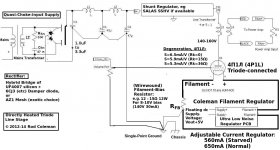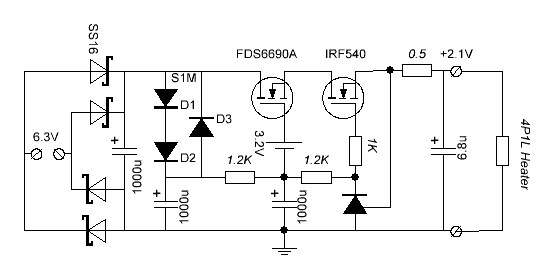Michael,
Please beware of the reduction in S (gm, mA/V) of the 4P1L, if you use 1K cathode resistor, with no bypass cap. This will reduce the gain to a low value.
You can bypass the cathode resistor (this sounds bad, if electrolytic capacitor is used), or you can use Filament Bias, like Ale does.
Hi Ron..
I would properly use a filament Bias, but this was more an attempt to get started. I still need to collect more parts before I can start.
Just did Ale ,old schematic in LT Spice to get an idea how it works.
Three Quick questions.
1) Which AC voltage is required, if I choose your Filament board for the 4P1L ???
2) And will it support operation with both 2.1 or 4.2 Voltage ???
3) Send a mail to jmsonline, and they can make whatever PSU trafo I choose.
Do you think it would be okay, regards the sound quality, If I make one with
3 sec , 1 for B+ and 2 separately for the filament ???
/Thanks Michael
Last edited:
Hi Michael
You need proper DC regulation for an DHT, like Rod's regulator. Anything else would really impact the quality of your stage, and if you are looking to save money on this, then I suggest you look at other options to ensure you are not frustrated with the resulting noise level, etc.
if you are looking to implement Rod's regulator then go for filament bias. 4P1L is ideal for this. Starved filaments at 550mA will take the filaments down to 1.9V if I remember correctly. Rod can give you all the parts for the board for 4P1L and you can set the current to 550mA accordingly.
The gyrator you built can be improved a lot. You can cascode the FET and also replace the potentiometer with a CCS and a resistor. Check my 4-65a/814 SE design. The resistor connected to the gate resistor and the capacitor should be around 4M7 and them you can reduce the gyrator cap to 220nF. Much better than a big 1uF
Ale
You need proper DC regulation for an DHT, like Rod's regulator. Anything else would really impact the quality of your stage, and if you are looking to save money on this, then I suggest you look at other options to ensure you are not frustrated with the resulting noise level, etc.
if you are looking to implement Rod's regulator then go for filament bias. 4P1L is ideal for this. Starved filaments at 550mA will take the filaments down to 1.9V if I remember correctly. Rod can give you all the parts for the board for 4P1L and you can set the current to 550mA accordingly.
The gyrator you built can be improved a lot. You can cascode the FET and also replace the potentiometer with a CCS and a resistor. Check my 4-65a/814 SE design. The resistor connected to the gate resistor and the capacitor should be around 4M7 and them you can reduce the gyrator cap to 220nF. Much better than a big 1uF
Ale
The filament transformers have to be separate from the HT, or you will pick up noise from the HT rectifier pulses.
jMS will do nice split bobbin trafos for this at a good price.
Send me an email and I will send you some designs for the LT supply when I get the time and am back home.
Ale
jMS will do nice split bobbin trafos for this at a good price.
Send me an email and I will send you some designs for the LT supply when I get the time and am back home.
Ale
Michael,
The ac voltage required for the 4P1L in filament bias will be set by the bias voltage you need. I can confirm the voltage you need, when your design is nearly finished.
Ale is right - the B+ transformer is better to be separate. The capacitor-recharge pulses of each different supply may cause noise for the other supply.
If you choose to use filament bias, the Filament Regulator must be able to drive different values of voltage: eg 550mA at 8,0V or 550mA at 14,5V - depending on the bias voltage you need to use. This is no problem for the Coleman Regulator. The Regulator can easily be set up to use 4,2V or 2,1V filaments also. But the best performance of the 4P1L is obtained with 2,1V 550-650mA - parallel filaments. This Regulator will give you the ultra-low noise performance you need for filament bias. This is not possible if IC Regulators like LT1085 or LM317 are used, because of their high levels of broadband noise.
The ac voltage required for the 4P1L in filament bias will be set by the bias voltage you need. I can confirm the voltage you need, when your design is nearly finished.
Ale is right - the B+ transformer is better to be separate. The capacitor-recharge pulses of each different supply may cause noise for the other supply.
If you choose to use filament bias, the Filament Regulator must be able to drive different values of voltage: eg 550mA at 8,0V or 550mA at 14,5V - depending on the bias voltage you need to use. This is no problem for the Coleman Regulator. The Regulator can easily be set up to use 4,2V or 2,1V filaments also. But the best performance of the 4P1L is obtained with 2,1V 550-650mA - parallel filaments. This Regulator will give you the ultra-low noise performance you need for filament bias. This is not possible if IC Regulators like LT1085 or LM317 are used, because of their high levels of broadband noise.
Michael,
The Regulator can easily be set up to use 4,2V or 2,1V filaments also. But the best performance of the 4P1L is obtained with 2,1V 550-650mA - parallel filaments. This Regulator will give you the ultra-low noise performance you need for filament bias. This is not possible if IC Regulators like LT1085 or LM317 are used, because of their high levels of broadband noise.
That's right - you can actually hear added noise with the LT1085, and I wouldn't even consider the LM317.
The fact that Rod's reg. is adjustable is incredibly useful in practice.
Don't even think of economising or simplifying the filament supply in filament bias. This is not a heater circuit in the traditional sense - the signal goes through the cathode resistor and so does the filament supply. It's all audible, and it all matters a lot including the quality of the cathode resistor - you need best wirewound, like porcelain coated. Not alu clad or ceramic or thick film.
Thanks, Andy....
For reference, I have attached a serving-suggestion for the 4P1L in filament-bias, transformer output version.
You can see the degeneration effect of the bias resistor: about 10%, if you choose 15Ω - for a typical bias of 8-9V or so.
4P1L is an excellent choice for experimenting with filament bias. It looks a bit wasteful of power, at first glance - but to get the same level of performance, you would need a separate transformer, rectifier, caps and a very low-noise regulator to generate a fixed-bias supply of equal quality to this circuit. The 3-terminal regulators would be fairly disastrous for this function, too!
For reference, I have attached a serving-suggestion for the 4P1L in filament-bias, transformer output version.
You can see the degeneration effect of the bias resistor: about 10%, if you choose 15Ω - for a typical bias of 8-9V or so.
4P1L is an excellent choice for experimenting with filament bias. It looks a bit wasteful of power, at first glance - but to get the same level of performance, you would need a separate transformer, rectifier, caps and a very low-noise regulator to generate a fixed-bias supply of equal quality to this circuit. The 3-terminal regulators would be fairly disastrous for this function, too!
Attachments
Thanks, Andy....
For reference, I have attached a serving-suggestion for the 4P1L in filament-bias, transformer output version.
You can see the degeneration effect of the bias resistor: about 10%, if you choose 15Ω - for a typical bias of 8-9V or so.
4P1L is an excellent choice for experimenting with filament bias. It looks a bit wasteful of power, at first glance - but to get the same level of performance, you would need a separate transformer, rectifier, caps and a very low-noise regulator to generate a fixed-bias supply of equal quality to this circuit. The 3-terminal regulators would be fairly disastrous for this function, too!
Thanks Rod. That circuit is almost exactly what I use, including the power supply. I use the transformer in 1:1 because this input stage is actually in my integrated 2-stage PSE 4P1L amp.
Rod, the floating dc vout is +5v? More like +15v I think?
Yes, it's "Vout + 5V", so for 2.1V of filament and 8V of bias (total 10.1V): 15.1V is the target input voltage.
4P1L still ringing, any suggestions.
HI.
Build my first Pre-AMP ever so I'm quite proud...
I have made it from Ales "little siberian" and I'm using Rod Coleman's filament
boards.
I'm running on 91 Volt on B+ , and Starving Starving the filament so I'm
having 1.65 Volt on the Tube...
I have some serious ringing , special when playing sitar, and other high
frequence instrument.
Tried Taping the Tubes. No luck.
My Enclosure or the lack of one, if very open, and the Amp is placed so
my speakers plays against it :-(.
The Sound Quality is Amazing, so Ḯ'm willing to try everything...
/Thanks Michael.
HI.
Build my first Pre-AMP ever so I'm quite proud...
I have made it from Ales "little siberian" and I'm using Rod Coleman's filament
boards.
I'm running on 91 Volt on B+ , and Starving Starving the filament so I'm
having 1.65 Volt on the Tube...
I have some serious ringing , special when playing sitar, and other high
frequence instrument.
Tried Taping the Tubes. No luck.
My Enclosure or the lack of one, if very open, and the Amp is placed so
my speakers plays against it :-(.
The Sound Quality is Amazing, so Ḯ'm willing to try everything...
/Thanks Michael.
Hi Michael,
congratulations and well done!! The sound of 4P1L in this stage is fantastic.
Some question / suggestions:
1. Move your linestage out of your speakers so feedback is reduced!
2. Have you tried suspending the socket as suggested earlier on this thread? Alternatively you can use rubber / silicon to dampen the physical connections to the socket. Many examples of this on similar threads
3. Try other 4P1L. Most of mine are low microphonic, so may be I've been lucky!
4. Andy and others have wrapped them in teflon plumbing tape with good success
Post pictures and schematics so we can better advise
Cheers,
Ale
congratulations and well done!! The sound of 4P1L in this stage is fantastic.
Some question / suggestions:
1. Move your linestage out of your speakers so feedback is reduced!
2. Have you tried suspending the socket as suggested earlier on this thread? Alternatively you can use rubber / silicon to dampen the physical connections to the socket. Many examples of this on similar threads
3. Try other 4P1L. Most of mine are low microphonic, so may be I've been lucky!
4. Andy and others have wrapped them in teflon plumbing tape with good success
Post pictures and schematics so we can better advise
Cheers,
Ale
Hi Rod....
Thanks for your allways quick reply. Rubber under the transformers helped me a lot.
Still a little, but better in any ways....
Do you know some very high quality sockets for the 4P1L....
Need some better than my NOS military, I have one which allready is
too loose. The music is scratching a little sometimes.
The sound quality is "need go back to 6922" anymore
Direct Heating and with the my Loftin White 2a3 quite happy....
Thanks for your extended help, from a newbie tube builder...
/Michael.
Thanks for your allways quick reply. Rubber under the transformers helped me a lot.
Still a little, but better in any ways....
Do you know some very high quality sockets for the 4P1L....
Need some better than my NOS military, I have one which allready is
too loose. The music is scratching a little sometimes.
The sound quality is "need go back to 6922" anymore
Direct Heating and with the my Loftin White 2a3 quite happy....
Thanks for your extended help, from a newbie tube builder...
/Michael.
Last edited:
I didn't actually go as far as decoupling the sockets, and I have no problems with 2v in. More problems when it was 0.5v.
But what worked for me is a massive chassis. Top plate is 4mm aluminium and the sides are either wood or 4mm alu. - nothing less. The worst ringing experiences I ever had were with lighter chassis - that doesn't work, you need mass here.
I also put my units on rolled up towels or something soft like that - you need to keep the unit off a hard surface.
All this has worked for me.
But what worked for me is a massive chassis. Top plate is 4mm aluminium and the sides are either wood or 4mm alu. - nothing less. The worst ringing experiences I ever had were with lighter chassis - that doesn't work, you need mass here.
I also put my units on rolled up towels or something soft like that - you need to keep the unit off a hard surface.
All this has worked for me.
Totaly agree with Andy.
I used 3mm top plate, heavy 3/4" hardwood cabinet ( cherry, oak), rubber grommets on sockets(enlarged holes to fit the grommets) attached in such a way that there is no metalic connection between the socket and the rest of the enclosure. In addition I have separate enclosure for the PSU. I have not had any issues with ringing. Indeed, I tested all tubes before using them. Some 4p1l are more microphonic then others.
Best,
Radu
I used 3mm top plate, heavy 3/4" hardwood cabinet ( cherry, oak), rubber grommets on sockets(enlarged holes to fit the grommets) attached in such a way that there is no metalic connection between the socket and the rest of the enclosure. In addition I have separate enclosure for the PSU. I have not had any issues with ringing. Indeed, I tested all tubes before using them. Some 4p1l are more microphonic then others.
Best,
Radu
Hi guys.
Thanks for your reply, I have done some mistakes in my wiring and before I'll
try something out in the sky, I'll post a picture 'surely real newbie'.
The problem is I have some 'bump' in the Left side, when I switch the output it will
be in the right side.
I have no hum, so the ground seems to be quite good.
From my 6922 i can see the following.
1) It separates the cathode to ground, has two wires here.
2) Left,Right ground from the Alps goes to each cathode.
3) Input from Alps to Grid is also separated.
Don't kill me , This is my first tube amp ever made
PS, I'm listening to my "6922" right now, my fantastic sound is a little on hole.
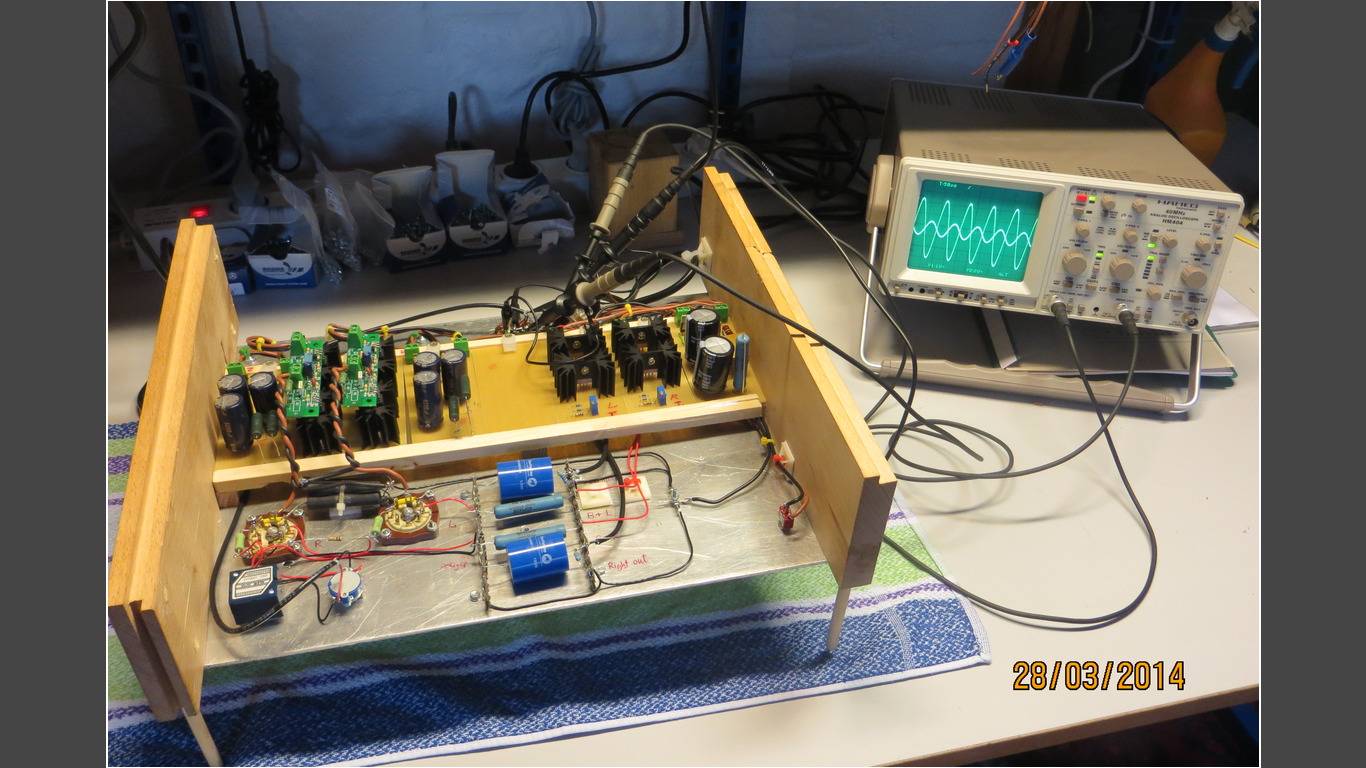
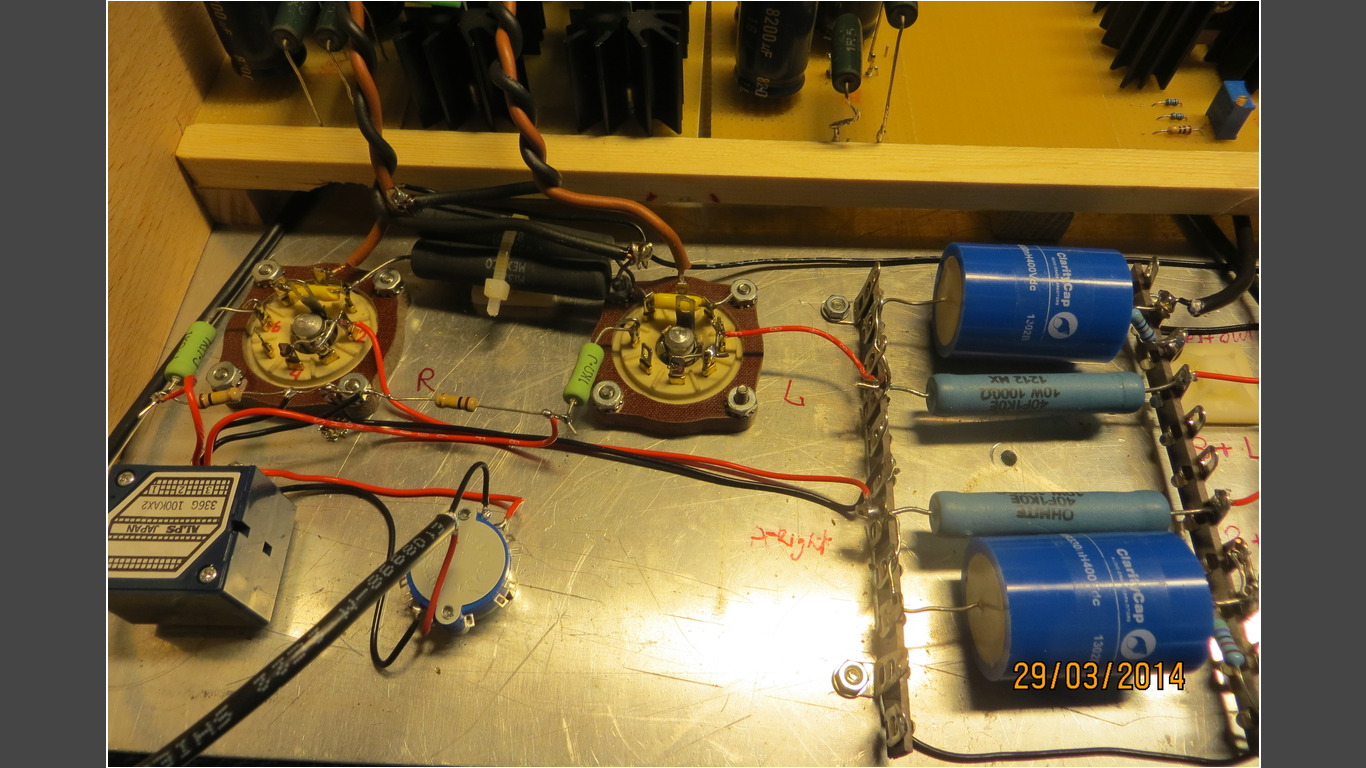
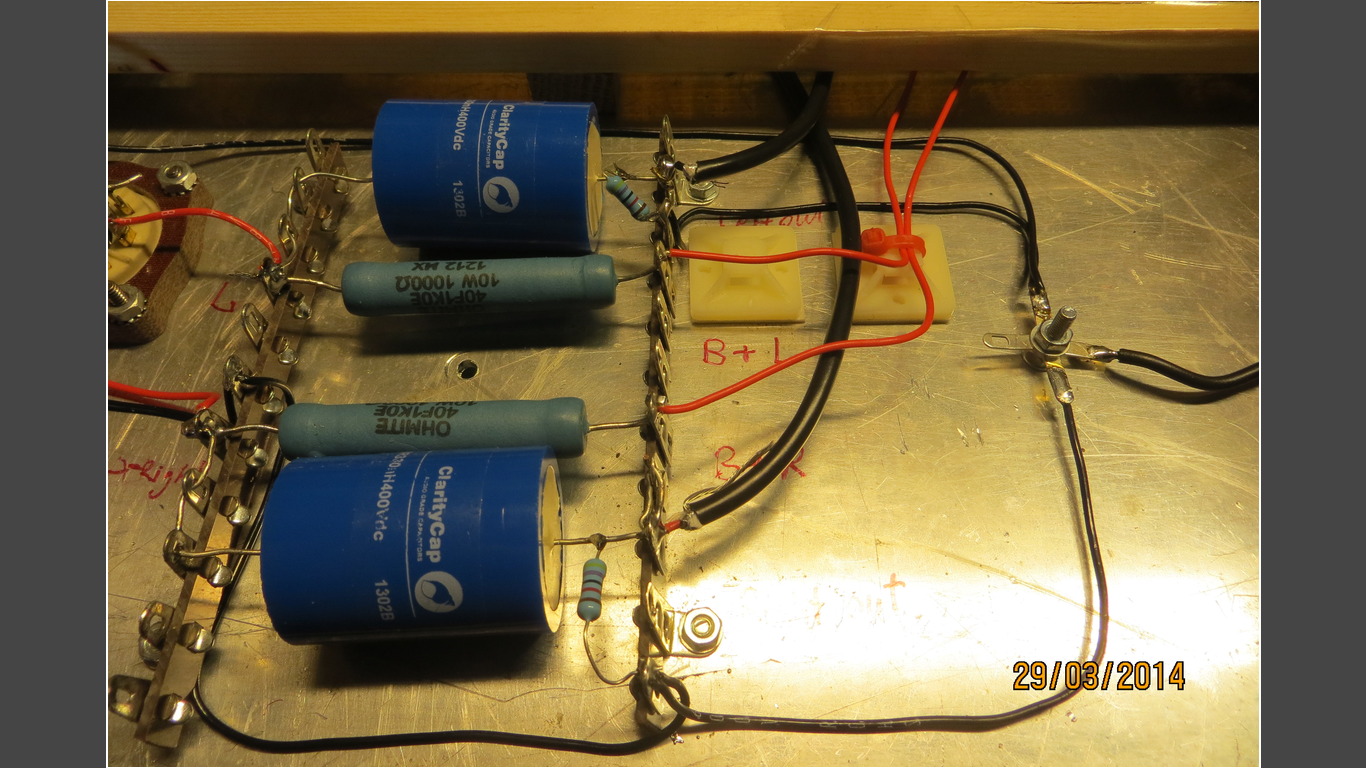
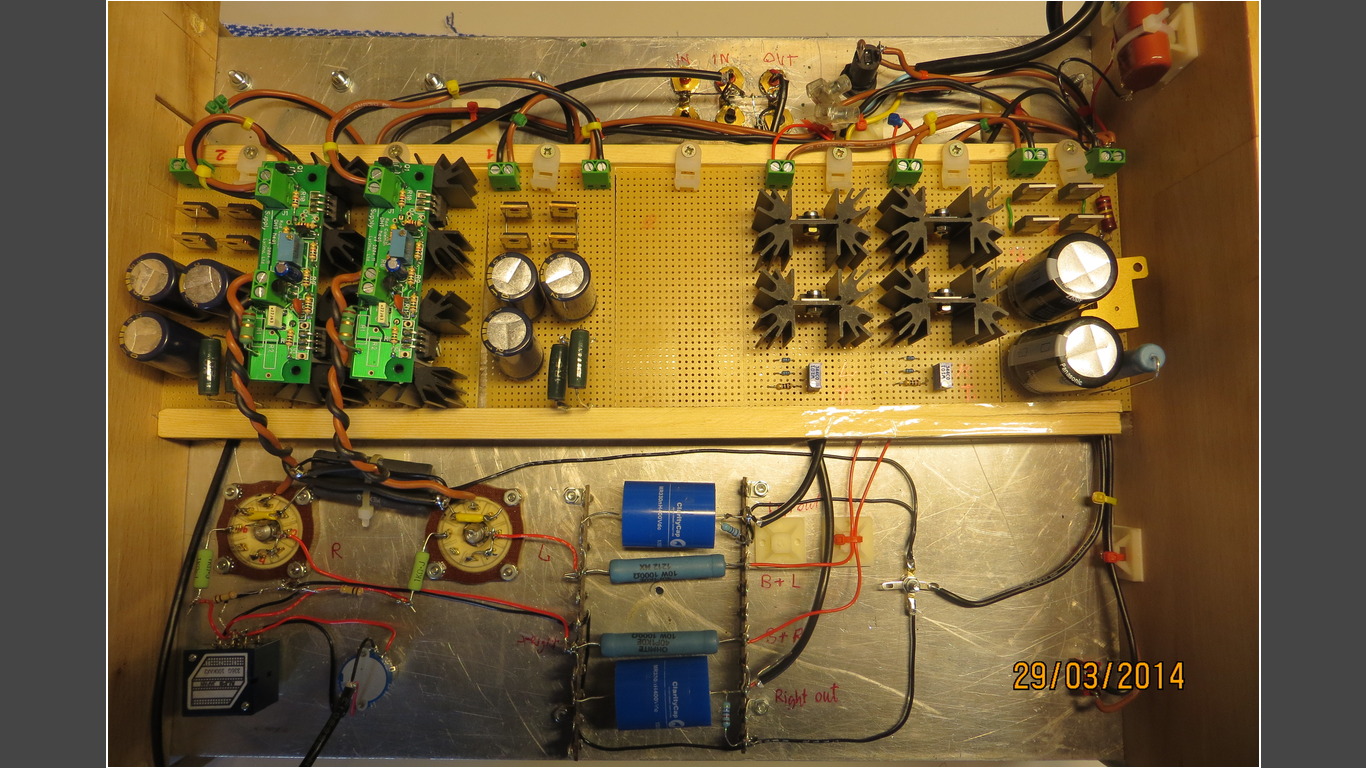
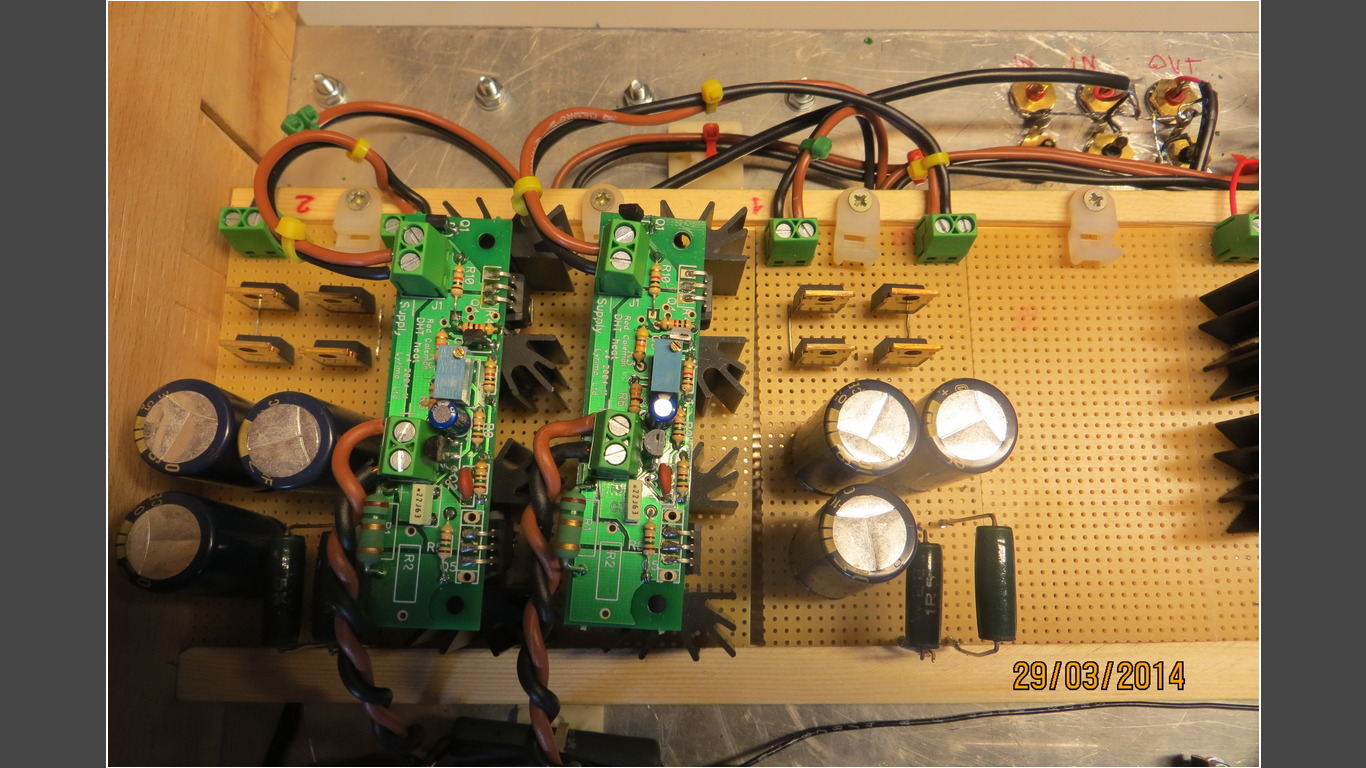
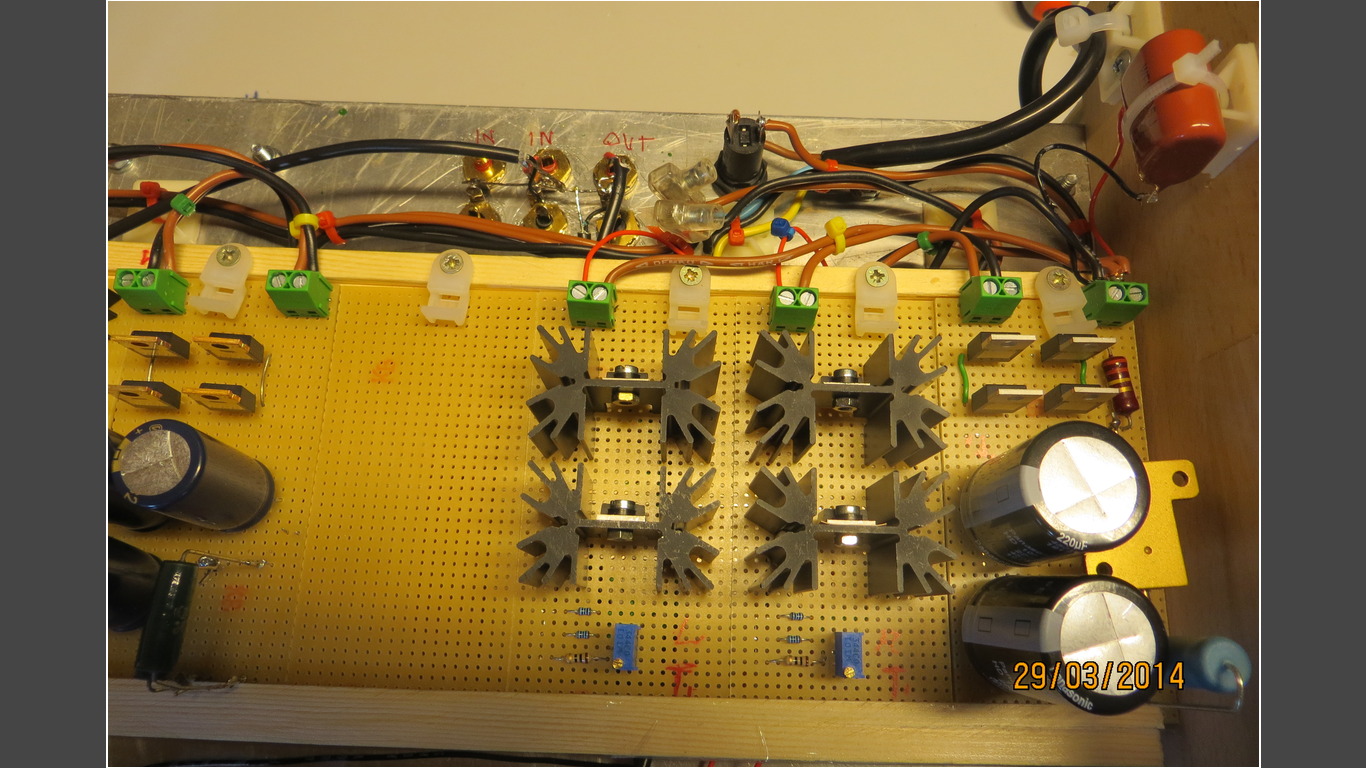
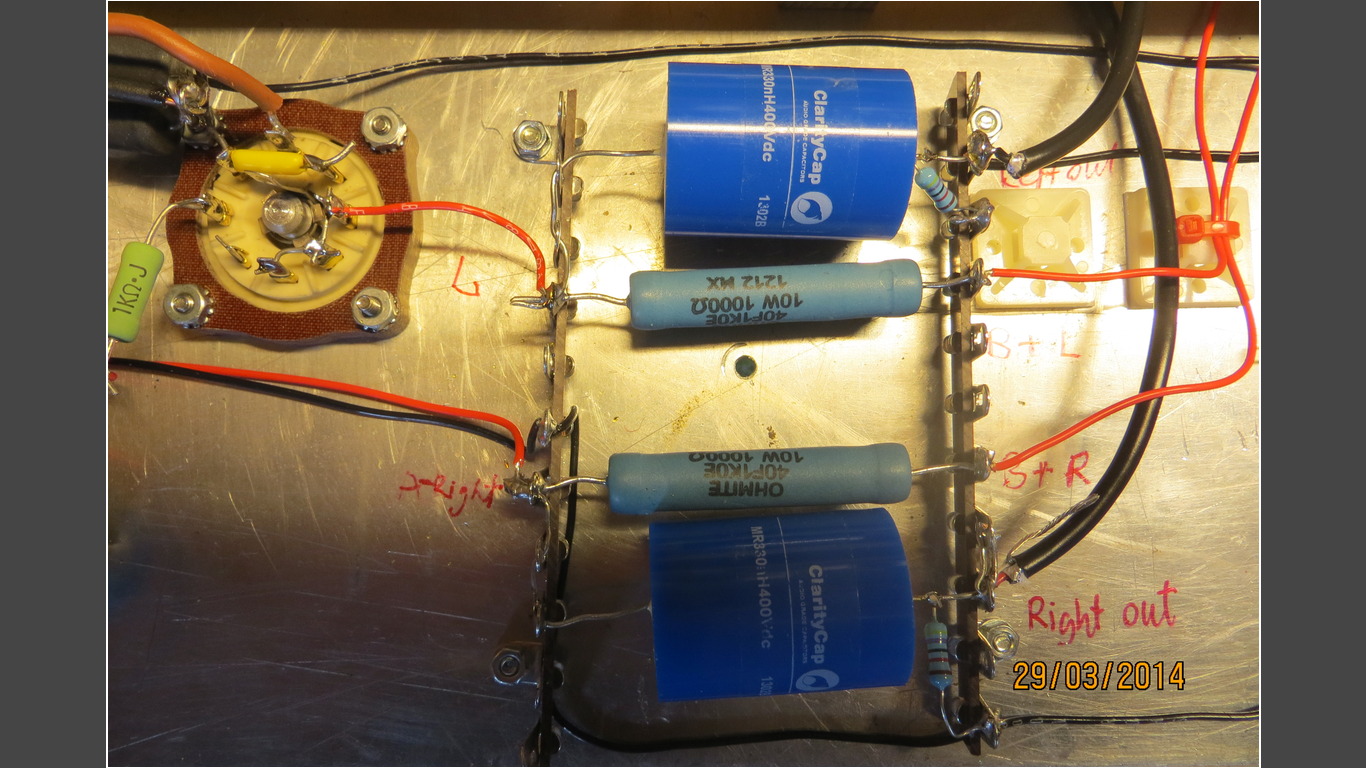
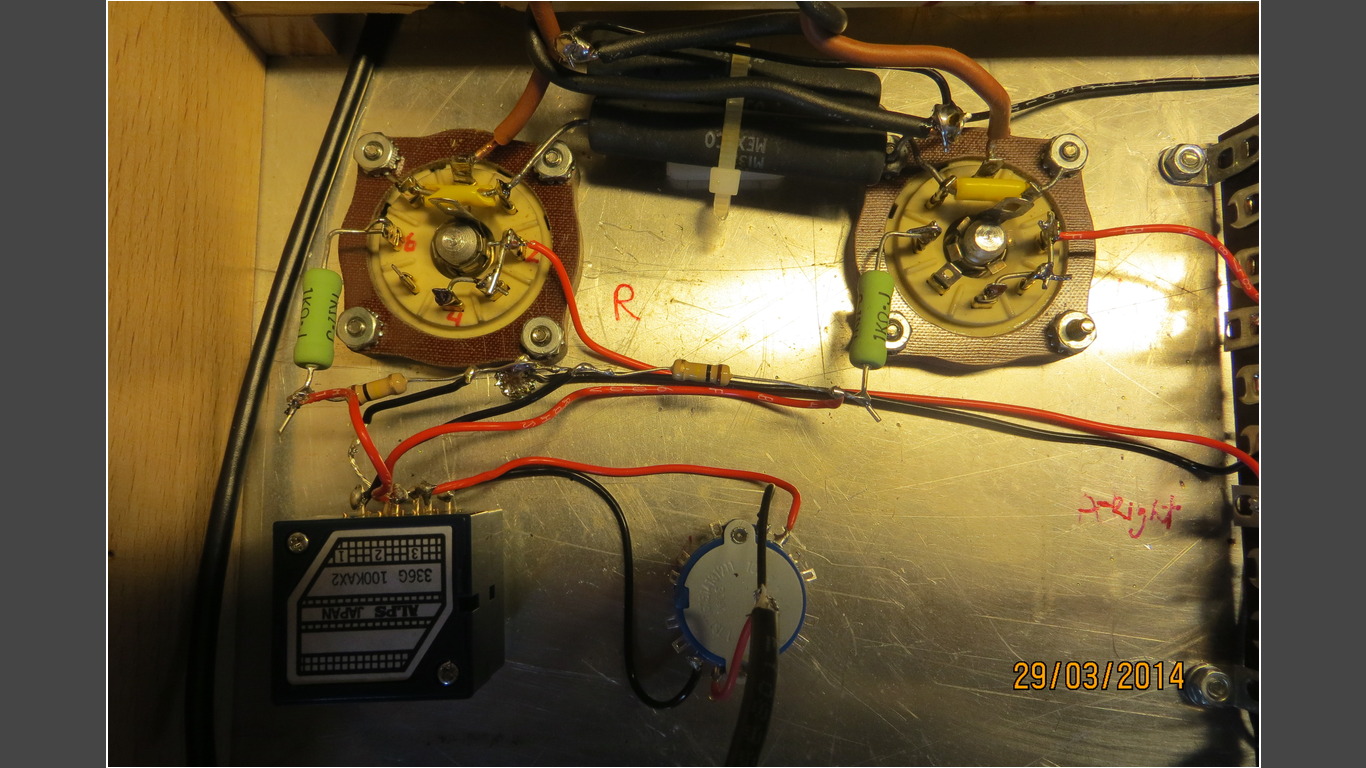
Thanks Michael
Thanks for your reply, I have done some mistakes in my wiring and before I'll
try something out in the sky, I'll post a picture 'surely real newbie'.
The problem is I have some 'bump' in the Left side, when I switch the output it will
be in the right side.
I have no hum, so the ground seems to be quite good.
From my 6922 i can see the following.
1) It separates the cathode to ground, has two wires here.
2) Left,Right ground from the Alps goes to each cathode.
3) Input from Alps to Grid is also separated.
Don't kill me , This is my first tube amp ever made
PS, I'm listening to my "6922" right now, my fantastic sound is a little on hole.
Thanks Michael
Last edited:
- Home
- Amplifiers
- Tubes / Valves
- 4P1L DHT Line Stage
